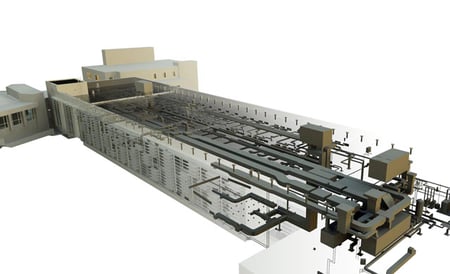What Is BIM Data And Why Is It Important?
 BIM or Building Information Modeling, is a way for designers and builders to pass along information regarding newly constructed facilities to facility owners. Most people think BIM is just three dimensional modeling, which is part of it, but what is important is the actual data delivered. BIM data can be used to effectively maintain facilities throughout their life-cycles.
BIM or Building Information Modeling, is a way for designers and builders to pass along information regarding newly constructed facilities to facility owners. Most people think BIM is just three dimensional modeling, which is part of it, but what is important is the actual data delivered. BIM data can be used to effectively maintain facilities throughout their life-cycles.
BIM's are embedded with large amounts of information relating to the bits and pieces that make up each facility. Data from BIM models can be formatted for easy import saving huge amounts of time that would normally go toward manual entry into other systems. Avoiding manual entry should be a priority because it is easy for it to be set aside in lieu of day-to-day tasks. Sitting on BIM data will cause it to become outdated and not very helpful. It is important for facility managers to pre-plan with owners to make sure BIM is integrated successfully.
Here is a BIM Startup Guide aimed at educating owners.
There are two questions facility managers should consider, when suggesting BIM requirements:
1. What information is going to be practical for maintaining facilities?
BIM models can contain a boat load of data regarding any given element in the model all the way down to the size and thread of screws that hold lighting on the wall. As a facility manager, when a new project is being contracted, make sure owners know the importance of BIM data and what is needed in order to effectively maintain facilities. If you currently have a Computerized Maintenance Management System (CMMS), take a look at the data you use and be sure to have that included in the contract. Data such as makes and models of assets as well as the square footage of spaces could be helpful but unknown to the owner to ask for in the BIM contract.
2. What format should the BIM be delivered in?
Format type is going to be determined by how you want to use the data. If you are familiar with software like Autodesks' Revit or Graphisofts' ARCHICAD and you have the software to edit files, requesting a three-dimensional model would be your best option. Asset and location data can be extracted from the model and imported into a CMMS or in some cases synced with a CMMS to ensure both the BIM data and the CMMS data are always up to date.
Simple Excel files can also be requested. The Construction-Operations Building Information Exchange (COBie) format is commonly used and is an accepted international standard. AEC firms are able to export BIM data into spreadsheets that follow the COBie format. From there, data can be imported into a CMMS and other management systems to be tracked. Documents referenced in spreadsheets, such as O&M manuals, will often be sent with the COBie Excel file. Here is an example of a COBie electronic deliverable from the National Institute of Building Sciences.
Getting more familiar with BIM, Revit, and COBie
If experience is needed with BIM, I highly recommend looking through these videos from the Autodesk Academy that go over common functions within Revit as well as ways of exporting data that facility managers would find useful. I've also included a video on BIM and the COBie format that does a good job of explaining why COBie was developed, how the spreadsheets are created, and what data is included.
Here are some other helpful articles:
5 Reasons To Do Preventive Maintenance
Ryan Noble
Ryan is Q Ware's Marketing Specialist.